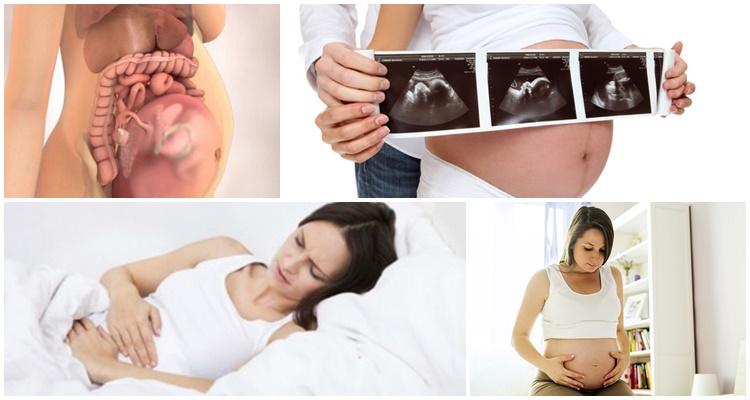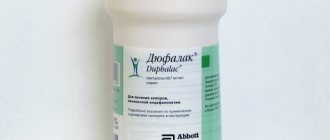An interesting situation is a long-awaited time in the life of every woman, because sooner or later she realizes that she is ready to give birth to a small miracle. However, the period of gestation is not as rosy as many imagine it to be and brings expectant mothers a lot of discomfort and various ailments.
Many are accustomed to associating the onset of pregnancy with toxicosis, although it may not exist and this is not considered a deviation from the norm. However, everyone around is just talking about intolerance to most aromas, about how they could not eat or drink anything, since the gag reflex occurred the first time they approached the kitchen, so most expectant mothers program themselves in advance that toxicosis will occur. This means it is important to know when exactly it will start.
What it is?
Slight morning nausea begins in pregnant women from the first weeks after conceiving a child. As a rule, it lasts until the beginning of the second trimester and goes away on its own if there are no pathologies during pregnancy. However, some women even note the absence of morning sickness and vomiting in the first months of bearing a child; this is due to the characteristics of the body of the expectant mother.
With the onset of toxicosis, the girl experiences nausea, changes in taste preferences and intolerance to the smell of certain dishes. In some cases, it is so strong that it causes bouts of vomiting, accompanied by dizziness. As a rule, such unpleasant symptoms manifest themselves more clearly in the first half of the day, but sometimes they make themselves felt in the evening. Toxicosis of the first trimester of pregnancy has virtually no effect on the fetus and its full development and stops in the 3-4th month of gestation.
If nausea continues to bother a woman carrying a baby in the second trimester, this may be evidence of disturbances in her body, threatening termination of pregnancy. Late toxicosis, starting from the 20th week, is called gestosis and, in addition to nausea and vomiting, it is manifested by general weakness of the whole body both in the morning and in the evening. Also, some pregnant girls develop swelling in the lower extremities and vision deteriorates.
In the last trimester of pregnancy, the phenomenon of toxicosis is especially dangerous, as it leads to increased blood pressure and dehydration due to incessant vomiting.
If it does not end by the last month of pregnancy, the girl is placed in a hospital under the supervision of doctors. For most pregnant women, the peak of unpleasant symptoms that darken the joy of expecting a child occurs in the first trimester, and does not pose a serious health risk.
nausea in early pregnancy what to do
The article was written by a mother-doctor. We don’t encourage anyone to do anything, it’s just worth reading and thinking about.
How the medications we are prescribed can affect the child. There are so-called critical periods of embryogenesis, when exposure to unfavorable factors (infections, drugs) is most dangerous:
— In the first weeks, damaging agents cause either the death of the embryo or leave no consequences (“all or nothing”)
- 3-8 weeks of pregnancy - the period of organogenesis, it is during this period that the teratogenic effect of drugs most often manifests itself (II critical period)
- 18-22 weeks - the most significant changes in the bioelectrical activity of the brain, hematopoiesis, hormone production (III critical period)
Now let’s look at the drugs that are used to poison unfortunate pregnant women in residential complexes:
1.No-spa (optionally, papaverine) is an antispasmodic, used to reduce the excitability of the uterus during pregnancy. Information about this remedy is very contradictory - from almost complete harmlessness to delayed speech development in a child. But since the real threat of abortion cannot be removed with no-shpa, there is no particular point in using it. By the way, papaverine is more effective.
2. Curantil (yes, I hate it fiercely!) is an antiplatelet agent, at the same time it is an inducer of interferon synthesis and has a modulating effect on the functional activity of the interferon system. The drug increases nonspecific antiviral resistance to viral infections, so it is used for the prevention and treatment of influenza, ARVI (as an inducer of interferon synthesis and an immunomodulator). In obstetrics, it is used to prevent placental insufficiency during COMPLICATED pregnancy (that is, if you, for example, have poor Doppler or coagulogram, taking chimes is in principle justified, but if the doctor in the gastrointestinal tract, with absolutely normal ultrasound/laboratory parameters, suggests drinking chimes for prevention, My advice to you is better buy yourself a couple of kilograms of fruit).
3. Aspirin, as well as other NSAIDs (indomethacin, ibuprofen) - taken in the early stages of pregnancy can cause cardiovascular abnormalities, malnutrition; taken in the third trimester - bleeding in the fetus, post-term pregnancy. So it is better to treat a headache with marital debt.
4. Actovegin. Despite the fact that it is widely prescribed to pregnant women to “feed the baby,” in many reference books pregnancy is NOT listed among the indications for its use, unlike the same chimes. The logical conclusion suggests itself that the effectiveness of Actovegin in complicated pregnancy is zero (however, no one has yet canceled the psychoprophylactic effect). And, by the way, this drug is prepared from the blood of calves, but guess three times who tends to get prion infections? Of course, prions love the tissues of the nervous system, but it’s not a fact that the pathogens don’t even think of strolling through the bloodstream. Considering their unprecedented vitality, I personally, when the doctor at the residential complex prescribed me Actovegin for regular prophylaxis, politely said that I would definitely take the nasty drug, but I never got to the pharmacy.
5. Ginipral is a drug that reduces the tone and contractile activity of the myometrium, a beta2-sympathomimetic, reduces the frequency and intensity of uterine contractions. I will give just a few interesting points:
a) if childbirth occurs immediately after a course of treatment with Ginipral, it is necessary to take into account the possibility of hypoglycemia and acidosis (!) in newborns due to the transplacental penetration of acidic metabolic products (at this point I would personally be particularly wary)
b) when using Ginipral, you should monitor the mother’s pulse and blood pressure, as well as the fetal heartbeat (well, of course, the doctor in the LCD who prescribes Ginipral will measure her blood pressure every day and do a CTG, who would doubt it!).
c) While using the drug, you should limit your intake of table salt with food. e) Ginipral is not recommended for use simultaneously with ergot alkaloids, as well as with drugs containing calcium and vitamin D, dihydrotachysterol or mineralocorticoids. And this drug is prescribed with might and main in antenatal clinics, and there is no talk of any doctor’s supervision - like, take the pills and come back in a couple of weeks!
6. Vitamin A - in the first trimester of pregnancy it can have a teratogenic effect (malformations of the central nervous system, cleft palate). The teratogenic effect of increased doses of retinol persists even after stopping its use (it accumulates in the liver), therefore it is recommended to plan pregnancy when using the drug after 6-12 months; for the same reason, large doses of vitamin A should not be prescribed to pregnant women (especially in the first trimester). By the way, vitamins D and K also exhibit a teratogenic effect when used in large doses during pregnancy.
7. Herbal medicine during pregnancy Contrary to popular belief about the complete safety of herbal preparations, I will give here a list that can easily be found on the Internet:
a) Herbs that can cause abortion: • Aloe arborescens - is part of gastrointestinal preparations, preparations that stimulate appetite, and is prescribed to stimulate the immune system. • Common barberry - found in antianemic preparations, recommended for improving liver function, stimulating appetite, for cholelithiasis, etc. • Oregano - used to improve appetite, in gastrointestinal, pulmonary-bronchial, sedative preparations. • Lovage officinalis - often used as a seasoning, included in sedatives, expectorants, diuretics and analgesics. • Buckthorn brittle - used as a laxative and for stomach ulcers. • Ergot is currently not often used in gynecological practice. Ergot is poisonous and absolutely contraindicated during pregnancy! • Garlic - widely used in herbal medicine. • Tansy is poisonous, increases the tone of the uterus, and increases blood pressure. It is part of many preparations: gastrointestinal, for anemia, headaches, swelling, chronic stress. • Radish is prescribed to improve appetite and improve digestion, for cholecystitis, bronchitis and colds. It may be useful a little later, after childbirth, as it increases lactation. • Curly parsley is often included in preparations for the treatment of cholelithiasis and urolithiasis, it is used as a diuretic for digestive and menstrual disorders. Placental circulation is disrupted, that is, blood circulation in the placenta, providing the baby with oxygen and nutrients: • Hyssop officinalis. Increases the tone of the uterus, increasing the risk of premature termination of pregnancy. It is part of the collection against bronchial asthma, gastrointestinal diseases, angina pectoris, neuroses, and anemia. • Wild strawberry - recommended for diseases of the stomach and intestines, urolithiasis, vitamin deficiencies, anemia, etc. It can increase the tone of the uterus and provoke premature termination of pregnancy. • Tripartite sequence - used in various skin preparations as a diaphoretic and diuretic.
b) They have an adverse effect on the mother’s body: • Mordovnik vulgaris increases muscle tone and increases sensitivity to pain, and is included in preparations for the treatment of a number of neurological and therapeutic diseases. • Licorice increases blood pressure and retains water in the body, causing swelling. It is often prescribed for chronic and acute diseases of the lungs and bronchi, and for some endocrine diseases. • An infusion of birch chaga mushroom also retains water in the body.
c) Herbs that aggravate the phenomena of early and late toxicosis Herbs in this group can sometimes be prescribed to pregnant women, but only for special indications and only by a herbalist who also has an obstetrics and gynecology specialization. They can cause nausea, vomiting, heartburn, flatulence, etc.: • Ledum marsh - poisonous, causes inflammation of the mucous membrane of the stomach and duodenum, dilates blood vessels, lowers blood pressure. Used mainly as an expectorant for bronchial asthma. • Valerian officinalis, when taken for a long time or at high dosages, can cause headaches, nausea, inhibit digestion, interfere with heart function and, oddly enough, increase nervousness. • Sweet clover is poisonous, causing headaches, dizziness, nausea, vomiting, and drowsiness. Included in expectorant and diuretic preparations. Prescribed for flatulence, insomnia, rheumatic pain. • Wormwood - prescribed to stimulate appetite, as a choleretic and for various chronic diseases of the gastrointestinal tract. Wormwood is dangerous if overdosed. It can cause seizures, hallucinations and other mental disorders. It is necessary to take into account that the organisms of a pregnant woman and her child are more sensitive to various chemicals, and doses (including infusions) should be reduced. • Greater celandine is a poisonous herb and can cause nausea, vomiting, diarrhea, and respiratory depression. Ingestion in the form of an infusion is recommended mainly for diseases of the digestive system. Increases blood pressure: • Sandy immortelle - prescribed for diseases of the gallbladder and liver. • St. John's wort (some authors classify it as a poisonous plant) constricts blood vessels, disrupts the blood circulation of the placenta, and increases blood pressure. It is used very widely in herbal medicine. • Calamus is contraindicated due to its pronounced diuretic effect, and is included in gastrointestinal and antiulcer preparations. • Blue cornflower - requires especially careful handling. Included in choleretic and diuretic preparations, used for cardiovascular and eye diseases, etc. Contraindicated due to the diuretic effect and the content of the cyanide complex. • Elecampane - used in expectorants and gastrointestinal preparations. • Madder - irritates the gastric mucosa and is prescribed for urolithiasis. • Juniper (berries) - used as a diuretic, laxative, diaphoretic, enhances the secretion of gastric juice. • Golden rhododendron is a poisonous plant, causing severe salivation, vomiting, pain in the stomach and along the intestines, bradycardia, respiratory problems, decreased blood pressure, and kidney depression.
d) Herbs that affect blood clotting • Knotweed, kidneyweed, pepper - in addition to a strong blood clotting effect, it causes contraction of the uterus with the risk of miscarriage. Included in preparations used for many diseases. • Burnet plant - used in preparations for cholecystitis, flatulence, enterocolitis, and respiratory diseases. • Cat's paw (also known as immortelle) has a strong blood clotting effect and increases blood pressure. • Stinging nettle is widely used in herbal medicine. In addition, it stimulates the sex glands, disrupting natural hormonal levels. • Corn (stigma) is usually recommended as a choleretic and diuretic. • Common ragwort - it causes palpitations, dry mouth, has a carcinogenic effect. e) Herbs that stimulate the sex glands and disrupt hormonal levels • Dandelion officinalis - is widely used in herbal medicine. • Walnut - can provoke spasm of cerebral vessels, increases blood clotting. • Melissa officinalis - used in preparations for many diseases. • Common hops - most often found in preparations for various kidney diseases and for the treatment of insomnia and nervous tension. • Cinquefoil anserina - is prescribed as a hemostatic and diuretic. • Black currant - prescribed for kidney diseases, vitamin deficiencies, bleeding and radiation sickness, hypertension, colds and as a choleretic agent. • Common yarrow - the plant is poisonous, causes dizziness, skin rashes, increases blood clotting and uterine tone. • Adaptogens: Aralia Manchurian, zamanikha, common ginseng, Leuzea safflower or maral root, Schisandra chinensis, Rhodiola rosea, Eleutherococcus senticosus. All of them also stimulate the sex glands, disrupting normal hormonal levels, and increase blood pressure, cause palpitations, tachycardia, insomnia, headaches, and increase nervousness. During pregnancy, they can be used only strictly according to indications, in reduced doses, shortened courses and always under the supervision of a doctor.
f) Simply poisonous plants The following are considered poisonous: • grass grass, • black henbane, • belladonna (or belladonna) • common cocklebur, • smokeweed, • high larkspur, • European hoofweed, • flat-leaved groundsel, • yellow egg capsule, • European bathwort, • common bird cherry, • sedum, • clematis, • euphorbia officinalis, • spurge, • soapwort, • comfrey, • sedum, • male fern, • white steppe, • evasive peony, • open lumbago, • rue fragrant, • common lilac, • horsetail.
Are you impressed, my dears? Now let’s take, for example, canephron - a drug that is widely prescribed to pregnant women for edema (believe it or not, they prescribed it to me too, but I ignored this prescription too - that’s just why my brain didn’t turn on when I started drinking chimes?), and which contains lovage, which has an abortifacient effect. Yes, there is a little lovage in the preparation, but no one has yet canceled the law of meanness and individual sensitivity! And when the aunt in ru_perinatal asks whether canephron can intensify uterine contractions, only the reluctance to be branded as a hysterical woman keeps me from advising me to pour the contents of the bottle into the toilet and change the doctor
8. Viferon The annotation states that it can be used in pregnant women with UROGENITAL INFECTION (chlamydia, genital herpes, cytomegalovirus infection, ureaplasmosis, trichomoniasis, gardnerellosis, human papillomavirus infection, bacterial vaginosis, recurrent vaginal candidiasis, mycoplasmosis) as an interferon-corrective agent (although Personally, even this approach seems very controversial to me). But, again, I constantly see messages in ru_perinatal that the doctor prescribed Viferon to prevent influenza or ARVI... As you know, the active ingredient in Viferon is alpha-interferon. We read about the effects of this cute remedy: during pregnancy, Interferon alfa is prescribed only if the expected effect for the mother exceeds the risk for the fetus. Can be used in the second half of pregnancy. Women of childbearing age should use reliable methods of contraception (!) for the entire duration of treatment. Although animal studies do not indicate the teratogenicity of Interferon alfa, the possibility that its use during pregnancy may cause harm to the fetus cannot be ruled out. When rhesus monkeys were given doses significantly higher than clinically recommended doses during early and mid-pregnancy, they experienced an increase in the number of miscarriages. Yes, interferon from suppositories is not absorbed very well, but where is the guarantee that this particular small dose will not stimulate your immune system so that a double dose of ginipral will not help? During pregnancy, there is a physiological suppression of the immune system, which is necessary in order to preserve the fetus, and why the hell should it be stimulated at all? Don't worry while it's quiet! (c)
9. Antihistamines - used in the treatment of allergic diseases (rhinitis, dermatoses, bronchial asthma). The fact is that histamine (against which the action of these drugs is directed) provides normal conditions for implantation and development of the embryo, promoting the transformation of endometrial stromal cells into decidual tissue , regulates metabolic processes between mother and fetus. That is, antihistamines can disrupt these processes. Most “popular” antihistamines used in the treatment of allergies are contraindicated during pregnancy. Thus, diphenhydramine can cause excitability or contractions of the uterus at a time close to childbirth, when taken in doses greater than 50 mg; after taking terfenadine, a decrease in the weight of newborns is observed; astemizole has a toxic effect on the fetus; suprastin (chloropyramine), claritin (loratadine), cetirizine (alleprtek) and fexadine (fexofenadine) during pregnancy are permissible only if the effect of treatment outweighs the potential risk to the fetus; tavegil (clemastine) during pregnancy should be used only for health reasons. These drugs can cause fetal resorption, pyloric stenosis, syndactyly, anal atresia, pulmonary hypoplasia, and hydrocephalus.
10. Glucocorticoids (prednisolone, dexamethasone, etc.) can lead to abnormalities in the development of connective tissue, intrauterine growth retardation, and fetal hypoglycemia.
11. Antibiotics - prescribed to pregnant women for infections. The safest for the fetus are penicillin drugs and cephalosporins. BUT: ampicillin, if used at the end of pregnancy, can cause increased jaundice in the newborn; cephalosporins can lead to hypoprothrombinemia and bleeding. Antibiotics of other groups are NOT RECOMMENDED for use in obstetrics! Nitrofurans (furagin, furazolidone) can cause hemolysis in the fetus. Doxycycline can cause irreversible discoloration of teeth, enamel hypoplasia, suppression of bone growth and skeletal fragility of the fetus, as well as the development of fatty liver. Metronidazole has an embryotoxic effect. Fluoroquinolones (ciprofloxacin, norfloxacin, etc.) have an arthrotoxic effect. Sulfonamides - have a teratogenic effect, increase fetal jaundice. Anti-tuberculosis drugs - gross abnormalities of fetal development, slow psychomotor development, convulsive syndrome, bleeding.
12. Drugs used during childbirth (note to fanatics!): Oxytocin - can cause sharp contractions leading to fetal hypoxia Promedol - can depress fetal breathing Local anesthetics (xycaine, lidocaine, trimecaine), used for paracervical, epidural, spinal anesthesia - fetal hypoxia, impaired fetal hemodynamics (bradycardia, decreased atrioventricular conduction) Drugs for general anesthesia: Thiopental sodium - central nervous system depression Sombrevin - hypoxia, acidosis Sodium oxybutyrate - central nervous system depression, muscle relaxation Nitrous oxide - hypoxia, acidosis Methoxyflurane, fluorotane - central nervous system depression
13. Eufillin is a bronchodilator, relaxes the muscles of the bronchi, blood vessels, has a peripheral venodilating effect, and increases renal blood flow. Stimulates the respiratory center, increases the frequency and strength of heart contractions. Use during pregnancy is possible only for health reasons, especially in the 3rd trimester, when the rate of its elimination from the body decreases: this drug freely penetrates the placenta and can cause tachycardia and rhythm disturbances in the fetus and newborn. Eufillin accumulates in the tissues of the fetus and can cause vomiting, diarrhea, and convulsions in a newborn. At this point, my enthusiasm died and I refused to remember the hellish medicines! You may ask, what to do now? Look for a sane doctor, study pharmacological and obstetric reference books, and, most importantly, listen to yourself, because no one has yet canceled intuition. If you experience cognitive dissonance at the sight of a package of pills (of course, in the absence of serious problems for you or your child), think: are they really necessary? Everything is good in moderation)))
Causes of the problem
Doctors cannot determine the exact reason why many women experience toxicosis while carrying a child. However, several provoking factors have been identified that contribute to the manifestation of unpleasant symptoms:
- Changes in hormonal levels. It is believed that the hormone, which begins to be produced from the moment a child is conceived, leads to nausea and vomiting in the first trimester. This is confirmed by the fact that the time of onset of symptoms of toxicosis and the peak of hCG levels coincide.
- Immune system response. At first, the protective forces of the female body perceive the embryo as a foreign body, which is why nausea and vomiting appear. As soon as the immune system gets used to the fetus, the symptoms of toxicosis disappear.
- Nervous reflex reason. According to scientists, with the onset of conception, the subcortical parts of the brain are activated. Since this is where the centers responsible for protective reflexes are located, the body reacts with nausea, vomiting, and dizziness.
- The presence of chronic liver diseases, thyroid pathologies, bad habits such as smoking and drinking alcohol.
- The age of the expectant mother. According to statistics, toxicosis, especially in the second half of pregnancy, more often torments those women who bear a child after 30 years.
- Psychological factor. In the presence of stress and anxiety about the course of pregnancy, unpleasant symptoms appear much more often than in the case when the girl is calm.
Also, the cause of the development of toxicosis is considered to be multiple pregnancy and a genetic factor; with a high degree of probability, if women in the family suffered from toxicosis, it will also torment the girl when carrying a child.
Toxicosis, poisoning or a cold?
Let's start with the fact that each woman's body reacts to everything that happens to it completely individually. Some ladies in an interesting position will never be able to support a conversation about toxicosis, because in all 9 months they have never met him. Others, on the contrary, experienced both early and late toxicosis.

Some expectant mothers doubt whether toxicosis exists in the first week or not. They can often mistake morning sickness for banal poisoning or a peculiar reaction to a common cold. But still, nausea during pregnancy can appear quite early, and this will be the very first signal that a new life has arisen in the woman’s body.
How does pathology manifest itself?
It is almost impossible not to notice the development of toxicosis during pregnancy, since it is accompanied by vivid unpleasant symptoms.
Specific signs include:
- The development of increased salivation in the early stages of pregnancy.
- The appearance of morning sickness, and in some cases, severe vomiting in the first half of pregnancy.
- Irritability and drowsiness during the daytime.
- Changes in taste preferences and intolerance to previously familiar foods.
- Loss of appetite, and against this background, weight loss.
- Dizziness and weakness.
- In rare cases, the development of dermatosis or asthma.
- The appearance of swelling of the lower extremities in the second trimester.
- Increased blood pressure in the third trimester, especially in the last month of pregnancy.
Toxicosis, which does not manifest itself with severe symptoms and disappears a few weeks after its onset, does not require specific treatment. If the discomfort is severe and affects the quality of life of a pregnant girl, it is necessary to consult a doctor to prescribe a course of therapy.

What time of day is it most common to feel sick during pregnancy?
There is a long-established theory on this question. It is believed that it is in the morning that expectant mothers feel excessive weakness, dizziness and nausea. The main recommendations of experts in this case are calmness, a light snack without getting out of bed, as well as extending the period of being under the covers by at least 5-10 minutes. So, by pampering yourself, for example with cookies, with additional minutes of tenderness in your favorite bed, you will allow your body to collect itself and calm down, which will result in great well-being throughout the day.
Main types
Doctors distinguish several types of toxicosis, depending on the intensity of the symptoms:
- In the first degree of pathology, vomiting occurs no more than 5 times during the day, and weight loss does not exceed 3 kilograms.
- In the second degree, the urge occurs about 10 times per day, and weight loss can be about 4 kilograms in 2 weeks. Toxicosis is accompanied by a decrease in blood pressure.
- Vomiting can occur up to 25 times during the day with the third degree of pathology. In addition, there is an increase in heart rate and an increase in temperature.
If toxicosis occurs with severe symptoms and does not end with the arrival of the second trimester, a diagnosis of “gestosis” is made and treatment is prescribed to prevent pregnancy complications.
Diagnostic measures
To clarify the diagnosis, first of all, the woman is interviewed by the observing gynecologist. After this, the pregnant woman is sent to donate blood and urine. If protein is detected in the urine in the late stages of pregnancy, they speak of the presence of preeclampsia. In addition to basic tests, an ultrasound examination is performed, since symptoms of toxicosis can also appear during a frozen pregnancy.

Additional examinations also include counting heart rate, measuring blood pressure and daily diuresis.
Symptoms
Nausea begins to develop at 5 weeks, manifests itself as mild malaise and ends with prolonged bouts of vomiting. In the latter case, additional medication may be required.
Other signs of early toxicosis:
- dizziness, less often – fainting;
- headache;
- slight malaise;
- general weakness, blues, apathy;
- decline in performance;
- drowsiness or insomnia;
- lack of appetite;
- weight loss;
- increased salivation;
- disturbance of habitual tastes and smells.
If such symptoms cause discomfort to a woman and cause mental anguish, it’s time to contact a gynecologist and individually determine a treatment regimen to relieve unpleasant symptoms.
Use of medications
In the first trimester, the list of medications that can be used to combat toxicosis is limited. This is due to the fact that during this period all the vital organs of the embryo are formed, and the chemical components of the drugs lead to developmental defects. It is recommended to relieve unpleasant symptoms with the help of activated carbon tablets. It is safe at any stage of pregnancy with short-term use. You can relieve nausea and vomiting by taking 1 tablet before meals.
Medicines such as Enterosgel or Essentiale Forte N help cope with the manifestations of toxicosis. However, it must be remembered that pathology can be treated with any medication only after consultation with a doctor.
When does nausea start?
Many women do not know at what stage pregnant women begin to feel sick, noting this symptom already 2 days after intercourse. However, all this is just an emotional mood.
The fusion of the egg with the sperm occurs in the fallopian tube, after which the resulting zygote moves to the endometrium over the course of several days. Next, the complex is implanted into the thickness of the mucous membrane, followed by its active development. While all this is happening, there can be no signs of pregnancy.
Starting from 3-4 weeks after conception, hormones are released into the blood, which provokes a response from the body. It is at this stage of pregnancy that a woman may first feel discomfort. Although during this period, nausea is rare.
If you ask several women at what stage their nausea began during pregnancy, no two identical answers will be given. Everything happens individually in each organism, however, on average, the first signs of toxicosis appear at 5-7 weeks of gestation, although later symptoms are possible, but they continue only during the first trimester.
Folk remedies
Folk remedies help get rid of the unpleasant symptoms of toxicosis. They do not have a negative effect on the development of the embryo and the mother’s body.
Simple recipes used to treat pathology at home:
- It is recommended to make cranberry juice daily and add a slice of lemon and a little honey. This drink can overcome an attack of nausea in a short time.
- Citrus juices (if you are not prone to allergies) suppress nausea if you drink them twice a day.
- Pumpkin juice has antiemetic properties. To combat an attack of nausea, you first need to suck half a teaspoon of honey and then drink the drink.
- Rosehip infusion is also effective in treating toxicosis. In addition to its antiemetic properties, it removes metabolic products from the body. Drink it 100 ml, three times a day, after meals. To improve the taste, add a teaspoon of honey.
If the attack occurs suddenly, just put a slice of lemon under your tongue and slowly dissolve it.

Nutrition for toxicosis
Many women mistakenly think that the less they eat, the less often they will feel sick. It is necessary not to reduce portions, but to reconsider the range of products. A properly formulated diet helps you survive the uncomfortable period of pregnancy.
You need to eat often (up to 5-6 times a day), but in small portions to reduce the load on the stomach. Vegetable soups and fresh salads made from broccoli and green beans help reduce the manifestations of unpleasant symptoms. You should abstain from dairy products for a while. It is recommended to steam food and not fry or bake it.
How to get rid of toxicosis
No one has yet been able to completely get rid of toxicosis, but you can alleviate the discomfort:
- You need to follow a daily routine, sleep at least 8 hours, avoid stress, and eat right.
- Arrange relaxation days for yourself: turn on pleasant slow music, sit back in a chair with a cup of your favorite tea, think about something good, about pleasant moments in life, about your future baby.
- It is necessary to adjust the diet for toxicosis. You should eat often, but little by little. Do not eat heavy, spicy, fatty foods. An empty or, conversely, full stomach increases the feeling of nausea.
To reduce lower abdominal pain and nausea, eat lemon or put it in tea. Decoctions of chamomile, mint, and ginger also help. But you need to be careful with the latest product.
A couple of days after fertilization, you can still feel sick, and the reasons for this are different, but not pregnancy. You just need to pay more attention to your health, and during pregnancy, don’t attribute all ailments to your condition, but get regularly examined by a doctor.
Don't wait for unpleasant signs of pregnancy. If the test turns out to be positive, you should bring more positive emotions into your life, be happy more often, walk in the fresh air, and do everything that brings pleasure. Think about your baby, imagine how he smiles at you. After all, when the mother is happy, the baby develops well and correctly.









